2007 FIAT SEDICI engine
[x] Cancel search: enginePage 166 of 266
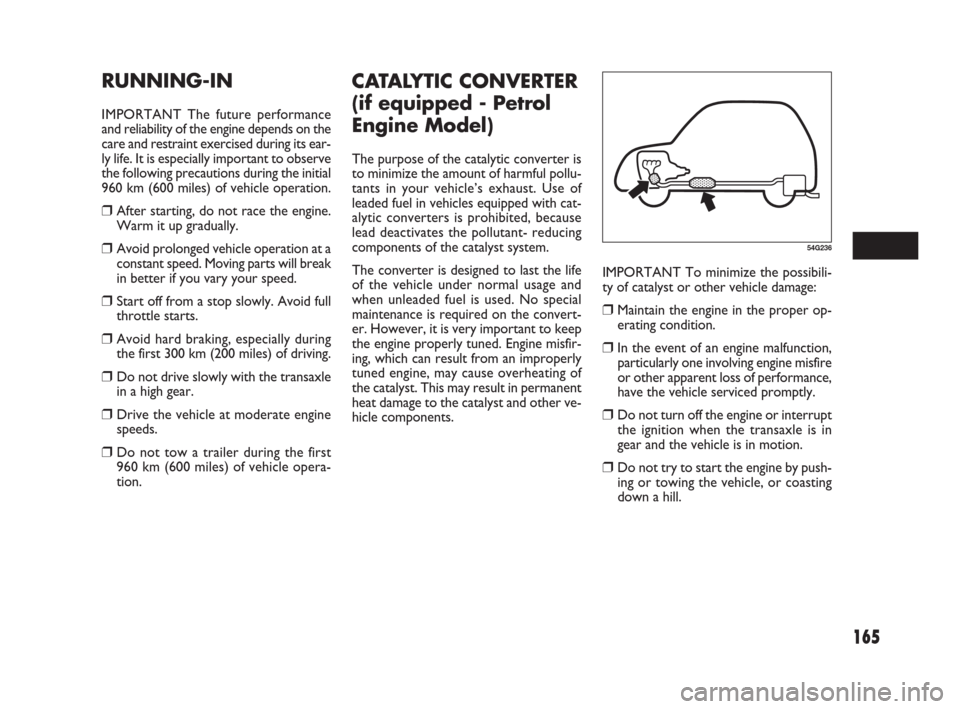
165
IMPORTANT To minimize the possibili-
ty of catalyst or other vehicle damage:
❒Maintain the engine in the proper op-
erating condition.
❒In the event of an engine malfunction,
particularly one involving engine misfire
or other apparent loss of performance,
have the vehicle serviced promptly.
❒Do not turn off the engine or interrupt
the ignition when the transaxle is in
gear and the vehicle is in motion.
❒Do not try to start the engine by push-
ing or towing the vehicle, or coasting
down a hill.
CATALYTIC CONVERTER
(if equipped - Petrol
Engine Model)
The purpose of the catalytic converter is
to minimize the amount of harmful pollu-
tants in your vehicle’s exhaust. Use of
leaded fuel in vehicles equipped with cat-
alytic converters is prohibited, because
lead deactivates the pollutant- reducing
components of the catalyst system.
The converter is designed to last the life
of the vehicle under normal usage and
when unleaded fuel is used. No special
maintenance is required on the convert-
er. However, it is very important to keep
the engine properly tuned. Engine misfir-
ing, which can result from an improperly
tuned engine, may cause overheating of
the catalyst. This may result in permanent
heat damage to the catalyst and other ve-
hicle components.
54G236
RUNNING-IN
IMPORTANT The future performance
and reliability of the engine depends on the
care and restraint exercised during its ear-
ly life. It is especially important to observe
the following precautions during the initial
960 km (600 miles) of vehicle operation.
❒After starting, do not race the engine.
Warm it up gradually.
❒Avoid prolonged vehicle operation at a
constant speed. Moving parts will break
in better if you vary your speed.
❒Start off from a stop slowly. Avoid full
throttle starts.
❒Avoid hard braking, especially during
the first 300 km (200 miles) of driving.
❒Do not drive slowly with the transaxle
in a high gear.
❒Drive the vehicle at moderate engine
speeds.
❒Do not tow a trailer during the first
960 km (600 miles) of vehicle opera-
tion.
149-166 Fiat16 New GB 27-11-2007 11:27 Pagina 165
Page 167 of 266
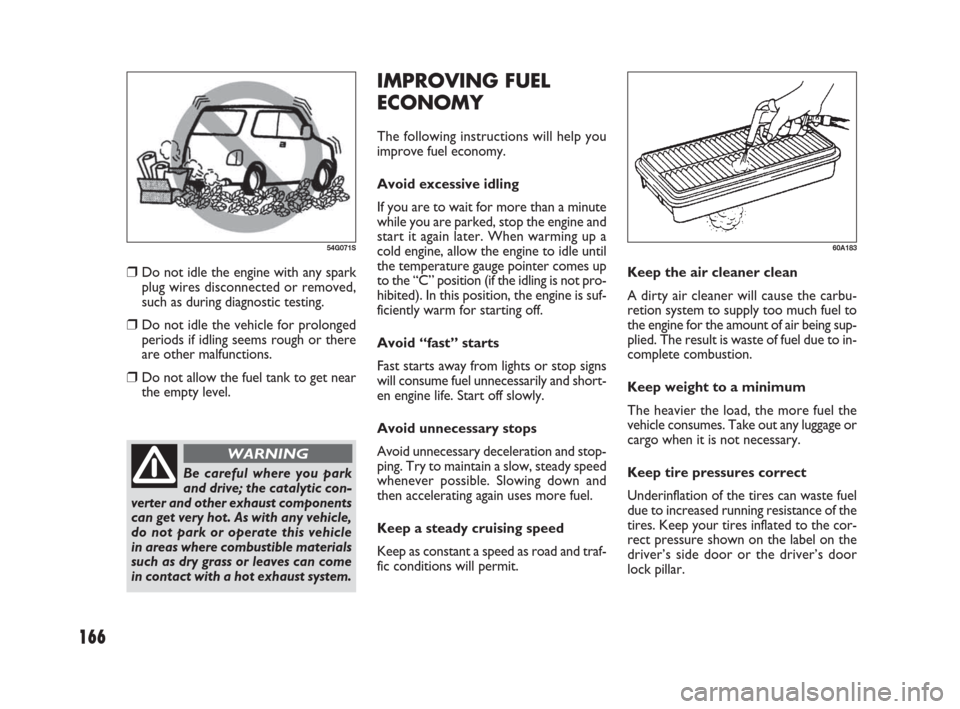
166
IMPROVING FUEL
ECONOMY
The following instructions will help you
improve fuel economy.
Avoid excessive idling
If you are to wait for more than a minute
while you are parked, stop the engine and
start it again later. When warming up a
cold engine, allow the engine to idle until
the temperature gauge pointer comes up
to the “C” position (if the idling is not pro-
hibited). In this position, the engine is suf-
ficiently warm for starting off.
Avoid “fast” starts
Fast starts away from lights or stop signs
will consume fuel unnecessarily and short-
en engine life. Start off slowly.
Avoid unnecessary stops
Avoid unnecessary deceleration and stop-
ping. Try to maintain a slow, steady speed
whenever possible. Slowing down and
then accelerating again uses more fuel.
Keep a steady cruising speed
Keep as constant a speed as road and traf-
fic conditions will permit.Keep the air cleaner clean
A dirty air cleaner will cause the carbu-
retion system to supply too much fuel to
the engine for the amount of air being sup-
plied. The result is waste of fuel due to in-
complete combustion.
Keep weight to a minimum
The heavier the load, the more fuel the
vehicle consumes. Take out any luggage or
cargo when it is not necessary.
Keep tire pressures correct
Underinflation of the tires can waste fuel
due to increased running resistance of the
tires. Keep your tires inflated to the cor-
rect pressure shown on the label on the
driver’s side door or the driver’s door
lock pillar.
60A183
❒Do not idle the engine with any spark
plug wires disconnected or removed,
such as during diagnostic testing.
❒Do not idle the vehicle for prolonged
periods if idling seems rough or there
are other malfunctions.
❒Do not allow the fuel tank to get near
the empty level.
54G071S
Be careful where you park
and drive; the catalytic con-
verter and other exhaust components
can get very hot. As with any vehicle,
do not park or operate this vehicle
in areas where combustible materials
such as dry grass or leaves can come
in contact with a hot exhaust system.
WARNING
149-166 Fiat16 New GB 27-11-2007 11:27 Pagina 166
Page 169 of 266
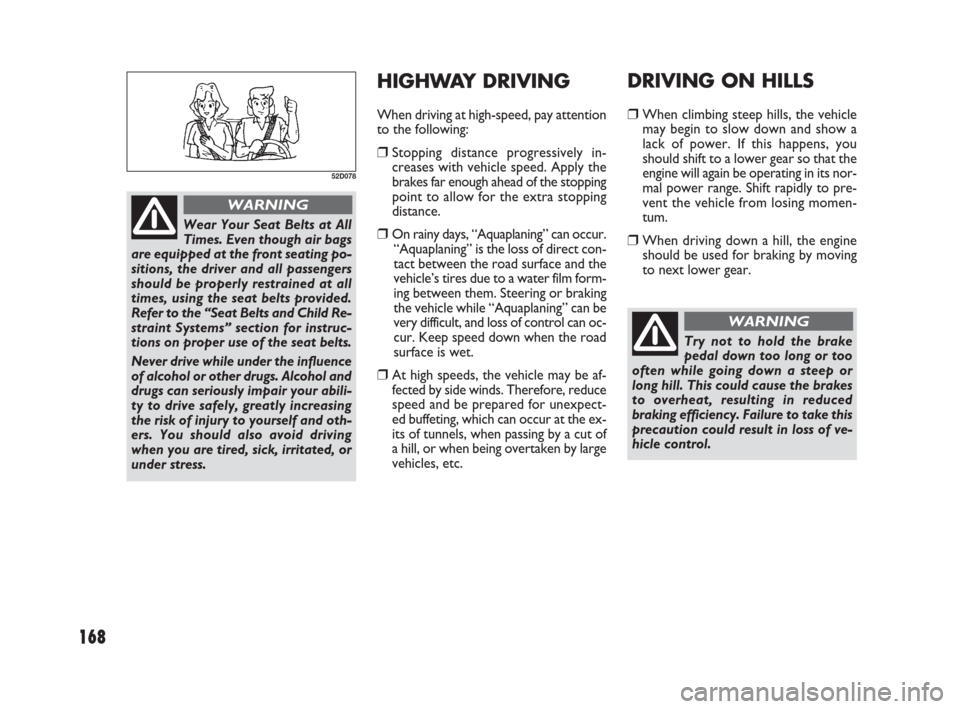
168
HIGHWAY DRIVING
When driving at high-speed, pay attention
to the following:
❒Stopping distance progressively in-
creases with vehicle speed. Apply the
brakes far enough ahead of the stopping
point to allow for the extra stopping
distance.
❒On rainy days, “Aquaplaning” can occur.
“Aquaplaning” is the loss of direct con-
tact between the road surface and the
vehicle’s tires due to a water film form-
ing between them. Steering or braking
the vehicle while “Aquaplaning” can be
very difficult, and loss of control can oc-
cur. Keep speed down when the road
surface is wet.
❒At high speeds, the vehicle may be af-
fected by side winds. Therefore, reduce
speed and be prepared for unexpect-
ed buffeting, which can occur at the ex-
its of tunnels, when passing by a cut of
a hill, or when being overtaken by large
vehicles, etc.
DRIVING ON HILLS
❒When climbing steep hills, the vehicle
may begin to slow down and show a
lack of power. If this happens, you
should shift to a lower gear so that the
engine will again be operating in its nor-
mal power range. Shift rapidly to pre-
vent the vehicle from losing momen-
tum.
❒When driving down a hill, the engine
should be used for braking by moving
to next lower gear.
52D078
Wear Your Seat Belts at All
Times. Even though air bags
are equipped at the front seating po-
sitions, the driver and all passengers
should be properly restrained at all
times, using the seat belts provided.
Refer to the “Seat Belts and Child Re-
straint Systems” section for instruc-
tions on proper use of the seat belts.
Never drive while under the influence
of alcohol or other drugs. Alcohol and
drugs can seriously impair your abili-
ty to drive safely, greatly increasing
the risk of injury to yourself and oth-
ers. You should also avoid driving
when you are tired, sick, irritated, or
under stress.
WARNING
Try not to hold the brake
pedal down too long or too
often while going down a steep or
long hill. This could cause the brakes
to overheat, resulting in reduced
braking efficiency. Failure to take this
precaution could result in loss of ve-
hicle control.
WARNING
167-170 Fiat16 New GB 27-11-2007 11:28 Pagina 168
Page 171 of 266

170
IMPORTANT Do not continue rocking
the vehicle for more than a few minutes.
Prolonged rocking can cause engine over-
heating or transaxle damage. IF YOUR VEHICLE GETS STUCK
If your vehicle gets stuck in snow, mud, or
sand, follow the directions below:
❒Shift the transaxle back and forth be-
tween first gear and reverse. This will
create a rocking motion which may give
you enough momentum to free the ve-
hicle. Press gently on the accelerator to
keep wheel spin to a minimum.
Remove your foot from the accelera-
tor while shifting.
Do not race the engine. Excessive
wheel spin will cause the tires to dig
deeper, making it more difficult to free
the vehicle.
❒If your vehicle remains stuck after a few
minutes of rocking, get another vehicle
to pull you out.
Do not allow anyone to
stand near the vehicle when
you are rocking it, and do not spin the
wheels faster than an indicated
40 km/h (25 mph) on the speedome-
ter. Personal injury and/ or vehicle
damage may result from spinning the
wheels too fast.
WARNING
54G074S
In addition to following the
driving tips in this section, it
is important to observe the following
precautions.
Make sure your tires are in good con-
dition and always maintain the spec-
ified tire pressure. Refer to “Tires” in
the “INSPECTION AND MAINTE-
NANCE” section for details.
WARNING
Do not use tires other than
those specified by Fiat. Nev-
er use different sizes or types of tires
on the front and rear wheels. For in-
formation regarding the specified
tires, refer to the Tire Information La-
bel located on the driver’s door lock
pillar.
Never use oversized tires or special
shock absorbers and springs to raise
(jack up) your vehicle. This will
change the handling characteristics.
Oversized tires may also rub against
the fender over bumps, causing vehi-
cle damage or tire failure.
After driving through water, test the
brakes while driving at a slow speed
to see if they have maintained their
normal effectiveness. If the brakes are
less effective than normal, dry them
by repeatedly applying the brakes
while driving slowly until the brakes
have regained their normal effective-
ness.
WARNING
167-170 Fiat16 New GB 27-11-2007 11:28 Pagina 170
Page 174 of 266
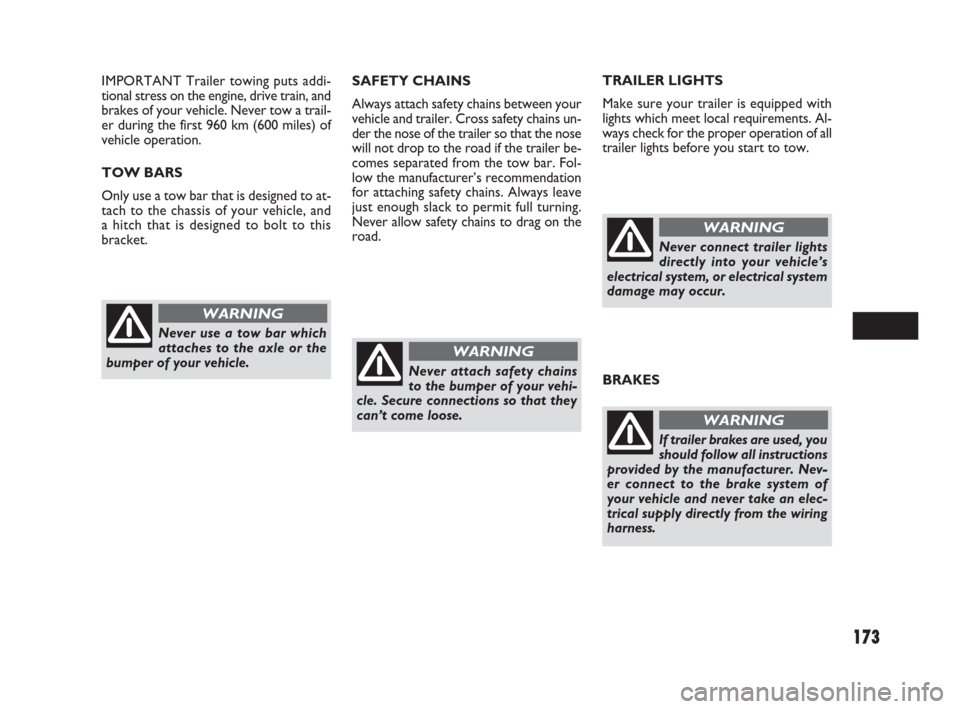
Never use a tow bar which
attaches to the axle or the
bumper of your vehicle.
WARNING
Never attach safety chains
to the bumper of your vehi-
cle. Secure connections so that they
can’t come loose.
WARNING
Never connect trailer lights
directly into your vehicle’s
electrical system, or electrical system
damage may occur.
WARNING
BRAKES
If trailer brakes are used, you
should follow all instructions
provided by the manufacturer. Nev-
er connect to the brake system of
your vehicle and never take an elec-
trical supply directly from the wiring
harness.
WARNING
173
SAFETY CHAINS
Always attach safety chains between your
vehicle and trailer. Cross safety chains un-
der the nose of the trailer so that the nose
will not drop to the road if the trailer be-
comes separated from the tow bar. Fol-
low the manufacturer’s recommendation
for attaching safety chains. Always leave
just enough slack to permit full turning.
Never allow safety chains to drag on the
road.TRAILER LIGHTS
Make sure your trailer is equipped with
lights which meet local requirements. Al-
ways check for the proper operation of all
trailer lights before you start to tow. IMPORTANT Trailer towing puts addi-
tional stress on the engine, drive train, and
brakes of your vehicle. Never tow a trail-
er during the first 960 km (600 miles) of
vehicle operation.
TOW BARS
Only use a tow bar that is designed to at-
tach to the chassis of your vehicle, and
a hitch that is designed to bolt to this
bracket.
171-180 Fiat16 New GB 27-11-2007 11:29 Pagina 173
Page 177 of 266
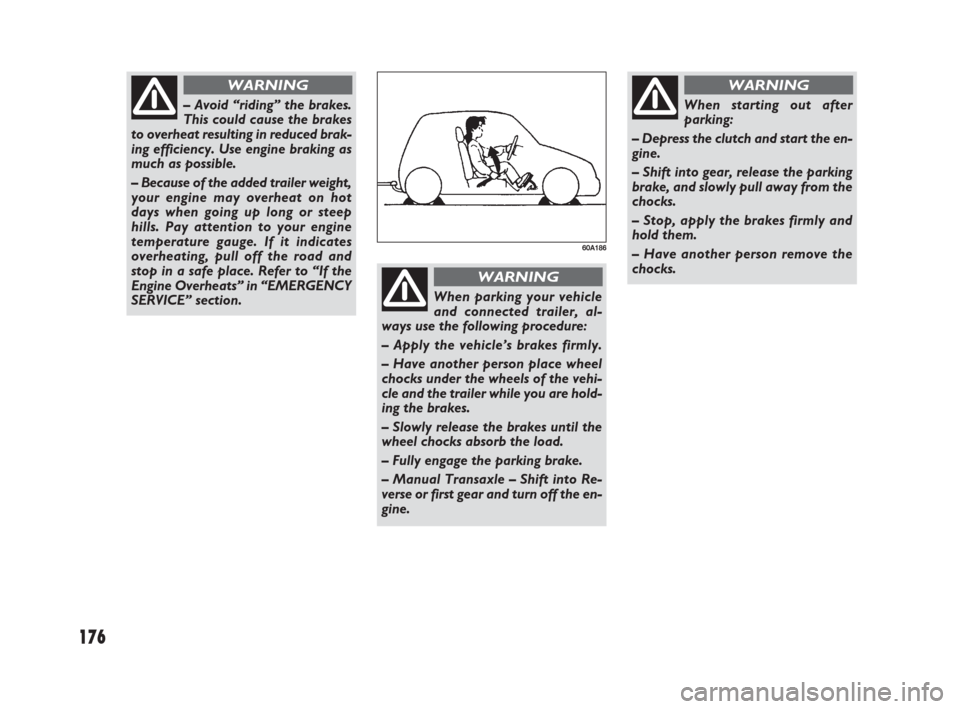
176
– Avoid “riding” the brakes.
This could cause the brakes
to overheat resulting in reduced brak-
ing efficiency. Use engine braking as
much as possible.
– Because of the added trailer weight,
your engine may overheat on hot
days when going up long or steep
hills. Pay attention to your engine
temperature gauge. If it indicates
overheating, pull off the road and
stop in a safe place. Refer to “If the
Engine Overheats” in “EMERGENCY
SERVICE” section.
WARNING
60A186
When parking your vehicle
and connected trailer, al-
ways use the following procedure:
– Apply the vehicle’s brakes firmly.
– Have another person place wheel
chocks under the wheels of the vehi-
cle and the trailer while you are hold-
ing the brakes.
– Slowly release the brakes until the
wheel chocks absorb the load.
– Fully engage the parking brake.
– Manual Transaxle – Shift into Re-
verse or first gear and turn off the en-
gine.
WARNING
When starting out after
parking:
– Depress the clutch and start the en-
gine.
– Shift into gear, release the parking
brake, and slowly pull away from the
chocks.
– Stop, apply the brakes firmly and
hold them.
– Have another person remove the
chocks.
WARNING
171-180 Fiat16 New GB 27-11-2007 11:29 Pagina 176
Page 182 of 266
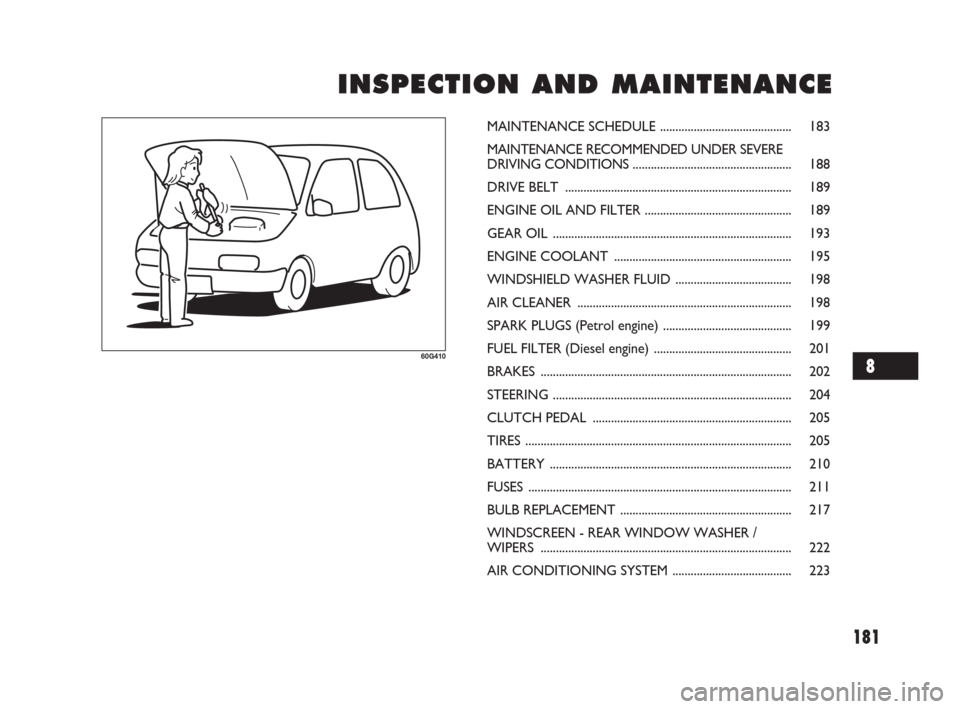
181
I I
N N
S S
P P
E E
C C
T T
I I
O O
N N
A A
N N
D D
M M
A A
I I
N N
T T
E E
N N
A A
N N
C C
E E E
60G410
MAINTENANCE SCHEDULE ........................................... 183
MAINTENANCE RECOMMENDED UNDER SEVERE
DRIVING CONDITIONS .................................................... 188
DRIVE BELT .......................................................................... 189
ENGINE OIL AND FILTER ................................................ 189
GEAR OIL .............................................................................. 193
ENGINE COOLANT .......................................................... 195
WINDSHIELD WASHER FLUID ...................................... 198
AIR CLEANER ...................................................................... 198
SPARK PLUGS (Petrol engine).......................................... 199
FUEL FILTER (Diesel engine)............................................. 201
BRAKES .................................................................................. 202
STEERING .............................................................................. 204
CLUTCH PEDAL ................................................................. 205
TIRES ....................................................................................... 205
BATTERY ............................................................................... 210
FUSES ...................................................................................... 211
BULB REPLACEMENT ........................................................ 217
WINDSCREEN - REAR WINDOW WASHER /
WIPERS .................................................................................. 222
AIR CONDITIONING SYSTEM ....................................... 223
8
181-224 Fiat16 New GB 27-11-2007 11:29 Pagina 181
Page 183 of 266
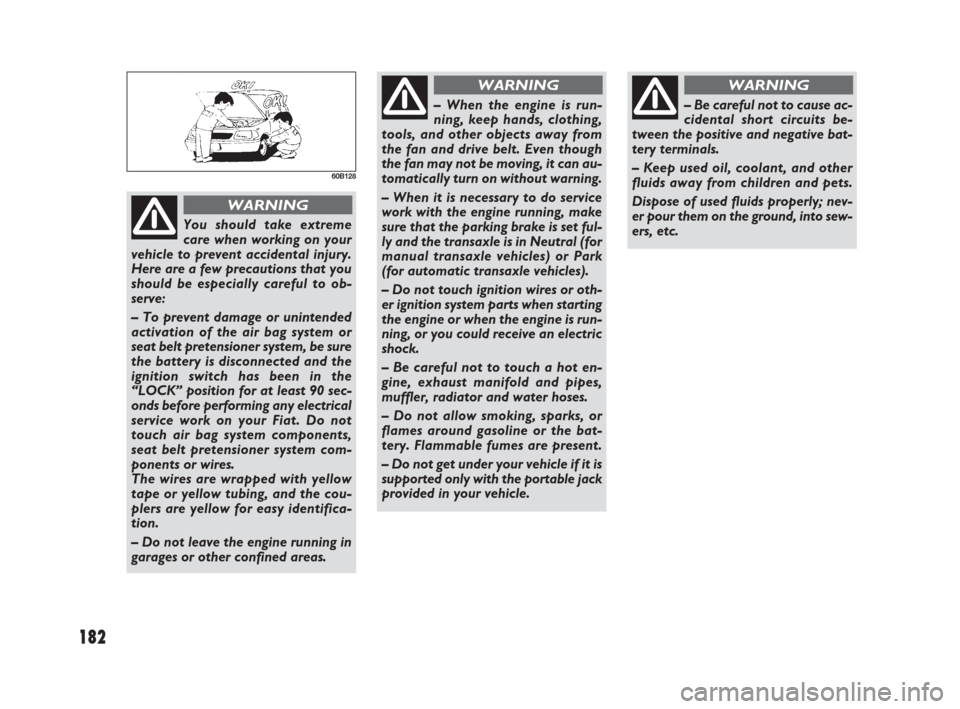
182
60B128
You should take extreme
care when working on your
vehicle to prevent accidental injury.
Here are a few precautions that you
should be especially careful to ob-
serve:
– To prevent damage or unintended
activation of the air bag system or
seat belt pretensioner system, be sure
the battery is disconnected and the
ignition switch has been in the
“LOCK” position for at least 90 sec-
onds before performing any electrical
service work on your Fiat. Do not
touch air bag system components,
seat belt pretensioner system com-
ponents or wires.
The wires are wrapped with yellow
tape or yellow tubing, and the cou-
plers are yellow for easy identifica-
tion.
– Do not leave the engine running in
garages or other confined areas.
WARNING
– When the engine is run-
ning, keep hands, clothing,
tools, and other objects away from
the fan and drive belt. Even though
the fan may not be moving, it can au-
tomatically turn on without warning.
– When it is necessary to do service
work with the engine running, make
sure that the parking brake is set ful-
ly and the transaxle is in Neutral (for
manual transaxle vehicles) or Park
(for automatic transaxle vehicles).
– Do not touch ignition wires or oth-
er ignition system parts when starting
the engine or when the engine is run-
ning, or you could receive an electric
shock.
– Be careful not to touch a hot en-
gine, exhaust manifold and pipes,
muffler, radiator and water hoses.
– Do not allow smoking, sparks, or
flames around gasoline or the bat-
tery. Flammable fumes are present.
– Do not get under your vehicle if it is
supported only with the portable jack
provided in your vehicle.
WARNING
– Be careful not to cause ac-
cidental short circuits be-
tween the positive and negative bat-
tery terminals.
– Keep used oil, coolant, and other
fluids away from children and pets.
Dispose of used fluids properly; nev-
er pour them on the ground, into sew-
ers, etc.
WARNING
181-224 Fiat16 New GB 27-11-2007 11:29 Pagina 182